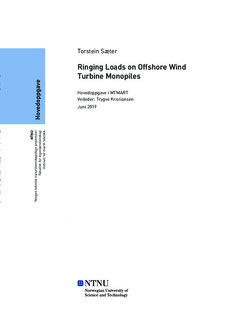| dc.contributor.advisor | Trygve Kristiansen | |
| dc.contributor.advisor | Ken-Robert Jakobsen | |
| dc.contributor.author | Torstein Sæter | |
| dc.date.accessioned | 2019-10-17T14:06:54Z | |
| dc.date.available | 2019-10-17T14:06:54Z | |
| dc.date.issued | 2019 | |
| dc.identifier.uri | http://hdl.handle.net/11250/2622944 | |
| dc.description.abstract | Kristiansen og Faltinsen(2017) bekreftet at ikke-viskøs FNV-theory, sammenlignet med eksperimenter, over-estimerte de tredje-harmoniske bølgelast amplitudene for lengre og brattere bølger. Beregning av lokalt KC-nummer langs vertikal akse på sylinderen, indikerte at virvelavlsøning var av betydning når avvikene oppsto. Derfor ble en last-beregnings modell, bestående av CFD og FNV teori laget, for å kunne ta hensyn til de visøkse effektene utelatt fra FNV-teorien. Resultatene fra denne kombinerte last-modellen sammenfallt derimot ikke noe mer med eksperimenter, enn hva ikke-viskøs FNV-teori gjorde. De tredje harmoniske amplitudene ble faktisk i noe sørre grad over-estimert sammenlignet med eksperimentelle verdier. Ulik modellering av strøm og grensesjikt ble fosøkt, for å se om dette kunne endre på resultatene. Selv om det ble påvist at dette hadde innvirkning på virvelavløsningen, og trykk-fordelingen på sylinderen, var de harmoniske lastene nesten identiske mellom bruk av ulike viskøse modellene. Inkluderingen av 2-D viskøse effekter ble derfor ikke påvist å kunne forklare avvikene mellom eksperimenter og FNV-teori i dette arbeidet.
Et eksperiment ble også gjennomført, får å studere utelatte 3D-effekter nøyere. Spesielt i fokus var en forhøyelse av den fri overflaten bak sylinderen, som har vært observert under mange eksperimenter med bølgelaster på en vertikal sylinder. Høyere harmoniske laster fra denne lokale forhøyelsen av fri overflate, kan muligens være årsaken bak avvikene i de tredje-harmoniske lastene mellom teori og eksperimenter. 3-D CFD er nødvendig for å kunne modellere denne effekten numerisk. | |
| dc.description.abstract | Kristiansen and Faltisen(2017) confirmed that the inviscid FNV-theory, compared to experiments, over-estimated the third harmonic wave load amplitudes on a bottom mounted vertical cylinder for longer and steeper waves. The local KC number along the vertical axis of the cylinder, indicated that the flow separates under the wave conditions where discrepancies in the third harmonic loads are present. Hence, the consequence of involving viscous effects in the analyses was investigated in the present work. A combined CFD-FNV load model was derived by replacing the force term proportional to the time-derivative of the velocity u in the FNV-theory, with an integrated CFD-force. However, compared with the inviscid fifth order FNV-theory, the load estimations from the CFD-FNV load model did not comply better with the experimental results. In fact, using the combined load-model, the third harmonic amplitudes were over-estimated slightly more for the steeper waves. Furthermore, several approaches of modelling the boundary layer, and the corresponding effects on the results, were investigated. Although the use of different viscous models affected the vorticity field around the cylinder, the load harmonic amplitudes remained by almost the same magnitudes. Thus, the involvement of 2-D viscous effects in the analysis during the present work, was not able to explain the observed discrepancies in the third harmonic loads.
An experiment was performed, in order to get deeper insight into 3-D effects that potentially could explain the discrepancies between the so-far tested load models and experiments. Several authors have observed and commented on a local rear run-up during experiments of regular waves on a slender bottom mounted vertical cylinder. The run-up is believed to be caused by a high pressure zone due to vortex shedding at the rear of the cylinder. The upwelling of the free surface was also observed during the experiment in the present work. Higher harmonic load contributions from the run-up may explain the discrepancies in the third harmonic loads. A 3-D CFD analysis would be necessary in order to account for this effect. | |
| dc.language | eng | |
| dc.publisher | NTNU | |
| dc.title | Ringing Loads on Offshore Wind Turbine Monopiles | |
| dc.type | Master thesis | |
